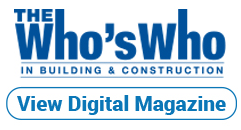A Now Approach to Life-Safety Needs
High Rise Security Systems, LLC

High Rise Security Systems owner Arnold Arredondo has more than 30 years of experience in life safety systems.

A fire alarm technician with High Rise Security Systems, LLC measures voltage with a digital volt meter to troubleshoot a communications failure.
Gone are the days when simple fire and smoke alarms warned building occupants of impending danger. Technology in the life safety industry has evolved so rapidly that integrated fire and security systems can now notify people about a variety of threats, ranging from a fire to an active shooter. Burr Ridge, Illinois-based High Rise Security Systems (HRSS), led by owner and General Manager Arnold Arredondo, is a top supplier of these high-tech systems.
With more than 30 years of experience in the industry, Arredondo has mastered the art of helping clients understand why life safety products not only must meet local fire codes, but also bring the valuable peace of mind that accompanies knowing their employees, tenants or whoever walks into their building can feel safe.
How Technology Saves Lives
Years ago, life safety systems relied largely on smoke or heat detection to trigger an alarm. Today, there are many other options to improve safety conditions in buildings and, Arredondo says, building codes require more of these systems than ever before.
Building codes now often require control systems that can support life even when a tragic event occurs in a building, such as a fire, an explosion, a hazardous materials incident or even an active shooter.
“The fire panels can provide added control functions that allow people to evacuate safely, to move from one compartment to another, or continue to use elevators depending upon particular events,” he says. “They can exhaust smoke and bring fresh air into the building. These fire (control) panels perform many functions.”
Arredondo says life safety systems sensors located in strategic locations report information back to newer computer-aided fire alarm panels. Then, panels communicate with these devices, sending back data that allows technicians to pinpoint the precise location of an issue—and assess its status. “Everything is point identified—with specific information with the time and date stamps. The panel reacts with specific sequences based on the received information,” Arredondo says.
Business Evolution
To keep up with the technology required to meet codes and customer needs, Arredondo says HRSS must provide the best life safety equipment possible. “Our flagship product line—NOTIFIER by Honeywell—is part of the key to our success,” he explains. “We offer terrific products and service to match.”
HRSS earned premier dealer status with Honeywell, which is a top-tier life safety product brand.
Beyond ensuring that his company is offering the best quality products, Arredondo says his business model has changed over the years. Early on, his company worked solely as a subcontractor supporting electrical contractors. Now, his customers also include general contractors, property development companies and end users.
“I think there are a couple of reasons for this evolution,” Arredondo says. “Over our 15 years in business, people began recognizing our brand and calling us based on our reputation. Also, the changes in the current building code make it favorable for us to work with end users directly. About 15 to 20 years ago, life safety was a second thought in construction; now, there is more emphasis on life safety going into buildings from their inception.”
The building codes are designed for the life safety system to act almost like a first responder by providing early warning alerts that protect people immediately from the time an emergency occurs. That requires higher quality equipment, more planning and better skilled operators, Arredondo says.
Safety Systems Market
HRSS works with new construction, but also does retrofits for buildings as well as renovation and rehab projects. Due to code requirements, all commercial buildings require some kind of life safety notification system.
Arredondo says the retrofit market makes up a big part of his business because if a renovation exceeds 50 percent of the building’s value, it must be updated to comply with current codes—like new construction. “Another important part of our business is repairing problem life safety alarms. Those systems are operating 24/7 and, at times, require service. There is no room for inoperable systems,” he says.
Arredondo says HRSS is mainly a “parts and smarts” vendor—meaning the firm provides the parts, but also has the manpower and brains to troubleshoot and work with electricians on their installation issues. The electricians install the pipe and wire, and HRSS makes the final connections, ensures the circuits are clear and certifies that the system is in place and working properly.
The customer base HRSS serves is almost exclusively commercial, ranging from large multifamily to industrial projects; high-rise resi- dential condominiums and daycare centers to churches; and hospitals, two- to three-story office buildings, strip malls and commercial offices of all sizes.
“They’re all important to us and are treated equally with great service and know-how,” Arredondo says.
To support their customers, HRSS has a team of 30 employees, including AutoCAD designers, factory-trained field technicians and staff that have achieved numerous levels of National Institute for Certification in Engineering Technologies (NICET) certifications. HRSS also holds several local, state and nationally recognized certifications—including having a Chicago business license, being licensed as a private alarm contractor in Illinois and achieving alarm service certification from UL—to prove that the company has the knowledge, abilityand credentials needed to properly and legally install alarm systems.
The Final Say on a Client’s Checklist
Making sure projects end on time is critical because life safety systems are the last item on a building owner’s checklist. “The building can be ready for occupancy, but until the fire department and other building officials sign off on the life safety system, no one is moving in,” Arredondo says.
“When we’re dealing with construction,” he continues, “we essentially hold the keys to the building. Because I’m the last tradesman in that building after carpet and other fine finishes, we are left with tight deadlines to perform our work. I’m a firm believer that we will perform, and we’ll put forward the resources to put us on the right track to make sure we meet the deadline. I’m proud to say that we have never missed a deadline.”
The life safety systems industry is much faster paced than when Arredondo started his company in 2004. “We have to be quick to respond to a customer’s request for pricing or service” Arredondo says. “We have to be a fast-moving company because customers have an entire list of providers at their fingertips with the ease of a Google search on their mobile phone.”
To ensure that his staff understands the importance in meeting a customer’s needs, he adopted a simple mission statement called “Ahora,” which means “now” in Spanish. “There is a need to act quickly in every opportunity,” he says, “from responding to an RFP (request for proposal) to answering phone calls, requests for service or even submitting an invoice. We have to treat everything with urgency and execute it quickly.”
Achieving New Heights
Meeting these deadlines has earned HRSS a strong reputation and many referrals and repeat business. Some of the bigger projects HRSS has been a part of include the Zurich North America headquarters in Schaumburg, Illinois, and the AMA Building, the Langham Chicago hotel, the LondonHouse Chicago hotel and the Blackhawk on Halstead building, all in Chicago.
The firm is certified as a City of Chicago Minority Business Enterprise (MBE), a minority contractor/vendor, an MBE, a Disadvantaged Business Enterprise (DBE) as well as having Illinois Department of Central Management (CMS) status and as an approved vendor with the U.S. General Services Administration (GSA).
“Government work is not easy. It puts pressure on an organization at all stages of work. We have taken on many government projects and have performed well. We welcome other opportunities without hesitation,” Arredondo says.
As sales grow, Arredondo says he wants to make sure he and his team never fall short of meeting client needs and providing quality work. The company still has a small business feel because he emphasizes person-to-person interactions. “Customers won’t get an automated answering service if they call the office,” he notes. “Employees’ personal cell phone numbers are on their business cards to encourage conversation and availability.”
Providing personalized service helps distinguish HRSS in the saturated life safety market. “When fire alarm panels do require service,” Arredondo says, “whether it is snowing heavily or on a holiday weekend, we are on call 24/7 because fire panels have to be functional all day and all night 365 days a year. We are there…to service these systems so they are 100 percent functional all the time. That’s the kind of company we have; we are there for our clients.”


 Login / Register
Login / Register

